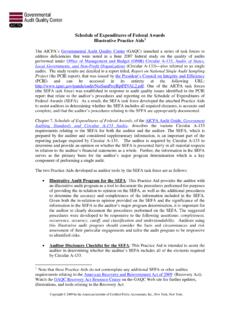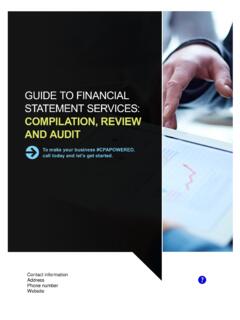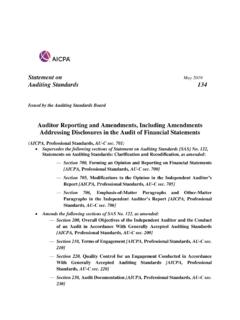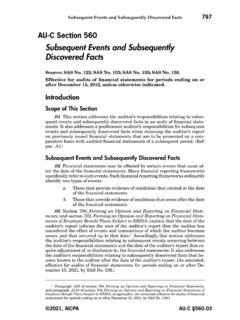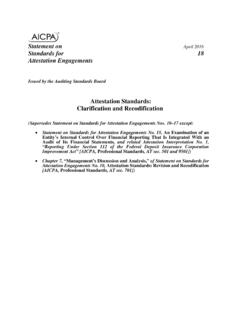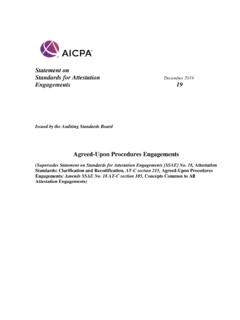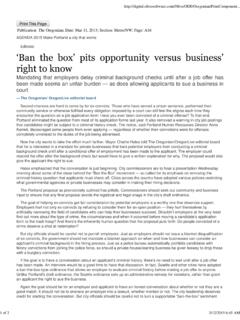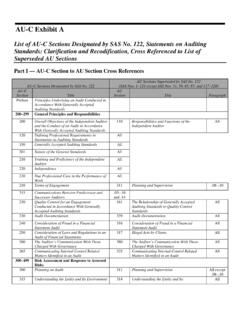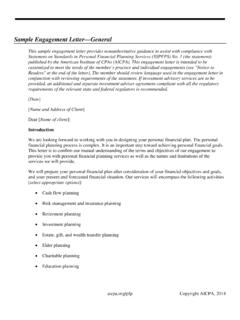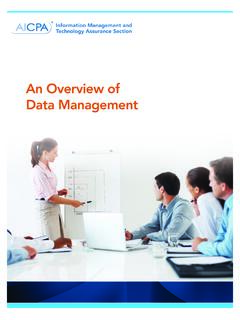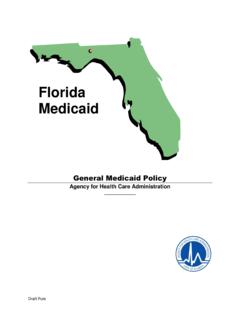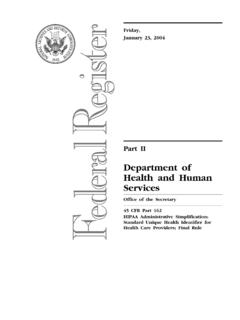Transcription of AICPA position paper on state pass-through entity-level ...
1 1 state pass-through entity-level TAX IMPLEMENTATION ISSUES BACKGROUND One of the provisions of the 2017 federal tax reform (Pub. Law No. 115-97, commonly referred to as the Tax Cuts and Jobs Act (TCJA)) was a limit on the amount of state and local taxes an individual can deduct for regular federal income tax purposes. Congress amended section 164 by imposing a $10,000 limit for most individuals and married couples filing a joint return and a $5,000 limit on married individuals filing There were no changes to the provision in section 164 that allows for the deduction for taxes paid in connection with a trade or business that are imposed on the business There were also no additional limitations placed on the deductibility of charitable contributions under section 170, but section 170 was The TCJA legislative history,4 as well as comments made by federal tax officials, indicate that the deduction for state and local income taxes paid by corporations was retained.
2 But no similar deduction was retained for entities other than C corporations. The individual owners of pass-through entities (PTEs) report their proportionate share of business income on their individual income tax returns and are subject to the $10,000/$5,000 annual limit of section 164(b) for state and local income taxes paid. PTEs include entities taxed under subchapters K and S of the Internal Revenue Code. These PTEs include S-corporations, partnerships, limited partnerships, limited liability partnerships (LLPs), and limited liability companies (LLCs). ISSUE In response to these new federal limitations, many state tax policy makers are proposing, and several state legislatures have enacted, various approaches to assist their taxpayers in mitigating this new limitation on the federal income tax deduction for state and local taxes.
3 One state legislative approach that several states have proposed, and one state already has enacted, is intended to shift the tax on PTE income from the owner to the PTE. Such an approach, its proponents believe, would allow the PTE to deduct the entity s state and local income taxes as a 1 All section references in this document are to the Internal Revenue Code of 1986, as amended, (IRC) or the Treasury regulations promulgated thereunder, unless otherwise specified. 2 TCJA, Sec. 11042(a) (amending IRC section 164(b). 3 TCJA, Sec. 11023 increased the adjusted gross income (AGI) limitation for individual donors cash contributions to operating charities from 50 percent to 60 percent.)
4 In addition, the Pease limitation, which phased out as much as 80 percent of the benefits of charitable and other itemized deductions for higher income taxpayers, was repealed. These changes will sunset after 2025. 4 See section 164(a) ( ..In addition, there shall be allowed as a deduction state and local, and foreign, taxes not described in the preceding sentence [which lists the various taxes for which a deduction under section 164 is permitted] which are paid or accrued within the taxable year in carrying on a trade or business or an activity described in section 212 (relating to expenses for production of income) ). See , House Rpt. 115-466, Tax Cuts and Jobs Act: Conference Report to Accompany 1, pg.
5 259 to 261. 2 tax on the business at the federal level, followed by a deduction for the PTE tax in the distributive share of the PTE owners income. These state proposals also would provide that the owner is permitted to claim a credit on the owner s state income tax return for the amount of the owner s distributive share of the taxes paid by the PTE. A PTE state -level tax was recently enacted in Connecticut, 5 and other states are considering similar proposals. As states consider enacting PTE-level taxes, states and state CPA societies should consider various perspectives and implementation issues regarding this approach. The multitude of methodologies that states employ to impose tax on income and capital, the potential lack of guidance from state authorities, and the variety of taxpayer-specific fact patterns will likely result in added compliance complexities.
6 In addition, it is uncertain whether federal tax officials will respect or challenge these approaches. IMPORTANCE TO CPAs Given the number of PTEs and the novelty of the recently enacted federal limitations on the deductibility of state and local taxes for PTE owners, we anticipate some states will consider enacting an entity-level tax with a corresponding credit to the PTE owners. PTE-level taxes will have broad federal and state tax consequences. CPAs regularly assist PTEs and their owners with tax compliance and planning, and interact with state tax authorities on their behalf. In addition, many CPA firms are formed as PTEs. CPAs are interested in working with state tax authorities and legislatures as they consider possible entity-level taxes on PTEs.
7 entity-level taxes have implications regarding both state tax revenues and state taxpayers, including PTEs and individual taxpayers. RECENT state ACTIVITY On May 31, 2018, the Governor of Connecticut signed into law Public Act 18-49 (Act) that contains a PTE-level tax. The Act imposes a entity-level income tax on most PTEs in Connecticut. Owners of PTEs are entitled to a credit against their Connecticut personal income tax equal to of the PTE owner s pro rata share of the PTE-level tax paid by their PTE. The state law grants a Connecticut resident owner of a PTE with a credit for any entity-level tax imposed by other states that the Connecticut Department of Revenue Services (CDRS) determines is similar to the Connecticut PTE-level tax.
8 The Act also provides that PTEs subject to the Connecticut PTE-level tax are required to make quarterly estimated tax payments. On June 6, 2018, the CDRS issued guidance regarding the Connecticut PTE-level tax and the estimated payment requirements In addition, 5 See entity-level Income Taxes on pass-through Businesses, Connecticut General Assembly, Office of Legislative Research, Heather Poole, Associate Analyst, 2018-R-0090, March 8, 2018. 6 SN 2018-4, issued June 6, 2018, provides guidance on estimate payment installments. Any owner and PTE may re-characterize their individual estimated payments to apply against the 2018 PTE estimated tax requirement.
9 3 CDRS issued additional guidance in OCG-6 (June 19, 2018) and OCG-7 (August 21, 2018).7 The Act and the Connecticut PTE-level tax is applicable for taxable years beginning on or after January 1, 2018. Under the Connecticut PTE-level tax, however, the PTE may elect to carve out the pro rata share of PTE income allocated to corporate owners from the calculation of the Connecticut PTE-level tax. The Act does not affect the taxation of publicly-traded partnerships, sole proprietorships, or single-member limited liability companies (SMLLCs) that are treated as disregarded entities for federal income tax purposes. Other states, such as New York, New Jersey and Arkansas, have announced that they are considering whether to enact their own PTE-level tax similar to Connecticut s.
10 Specifically, the New York Department of Taxation and Finance released its own draft of a proposed Unincorporated Business Tax (UBT), which, similar to the Connecticut tax, would provide a credit for PTE owners against their corresponding New York state personal income tax AICPA position The AICPA encourages state CPA societies to advocate for fair, reasonable, and administrable tax rules that minimize the complexities and burdens to taxpayers and state tax authorities alike. The AICPA does not take any position on these state tax proposals, either as a concept or on any of the specific legislative drafts that some states have recently released. To assist state CPA societies, the AICPA identified the following list of issues for consideration in evaluating any proposed state PTE-level This list is not intended to support or oppose any proposal, but to provide a guide for discussion of any such proposal.
